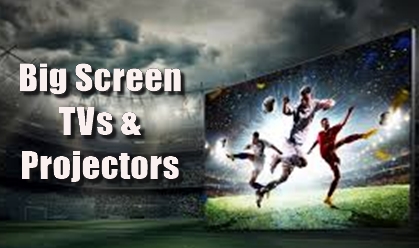If sport figures highly in your offering, sorting out your TV or Big Screen systems is a must. Most of your customers will have a plasma or LCD TV in their home and they will expect the same level of viewing quality in the pubs they use as well.
A big screen projector or large Plasma TV can attract new customers so use a banner, A-board or chalkboard outside your pub to tell everyone you have big screen and show football, racing and other sports.
According to research customers will visit your pub more often if it has a big screen or large TV, many will stay longer because of the screens and most agree that screens improve the atmosphere in a pub.
Remember that many customers also hate TV’s being part of the pub environment so I generally try and create at least one area which is screen-free and ensure that TV’s are only put on for advertised sporting fixtures and not just left on all day and night. If your system is connected to your background speakers make sure that you also have an area which is not blaring out the commentary and action. If only a few customers are actually watching a match / race then limit the number of screens and if they have them use their built in speakers not your surround sound system.
Now you’ve decided that you need a system here’s a guide to buying and setting up a plasma/ LCD or TV projector to best effect in your pub. This guide will help you make informed choices on buying the TV systems you need for your pub.
Where are you placing it? What peripheral devices will you need? Which size and what specification of plasma TV or LCD or Projector do you need? What about installation? How much do they cost?
Placement
In setting up the environment for your plasma TV, you need to determine the screen size to match the floor plan or available space where the plasma will be displayed.
Plasma monitors are measured diagonally across the screen, just like any other television set and range from 32” to 63”. Generally the bigger the screen the bigger the distance to view it is required.
Sitting too close means you can see the dots (pixels) that make up the plasma display whilst sitting too far away reduces the experience of sharpness that Plasma TVs produce.
A rough guide to viewing distances from varying screen sizes is: 32″ to 37″ (6-10 ft); 42″ to 46″ (10-14 ft); 50″ (12-16 ft) 60+”(15+ft)
Lighting is very important in the area where your plasma TV is set up. Plasma TVs generally work well in rooms with regular indoor lighting, however, direct sunlight can obscure the view. Make sure you have adequate curtains or blinds over windows.
You will also need to consider what is called the Viewing Angle, when siting your screen, remember that 170° is the maximum for everyone to see the picture clearly.
Peripherals
If you want to connect your plasma TV to a DVD player, VCR, satellite TV receiver (such as Sky) or video game system (such as Wii) you’ll need to check that you can. When comparing plasma TV sets make sure it can take all the necessary input signals these devices use. With the advent of HD TV make sure your set is able to receive HD. The various suppliers I have used recommend a contrast ratio of 1,000 to 1 and a brightness rating of 550 cd/m². These will give you the best picture quality.
A good plasma screen will allow for 60,000 hours viewing (approximately 20 years, 8 hours a day), but to ensure you get the longest life make sure the set has anti-burn-in protection.
If you plan to use an external sound system, you won’t need audio speakers, but most plasma TV sets include speakers that rated anywhere from 7-12 Watts. Check your plasma’s specifications to see if it comes with speakers and if the speakers are removable.
Plasma screens use a lot of electricity so compare and contrast the ratings of sets you look at.
Continue reading … page 2
